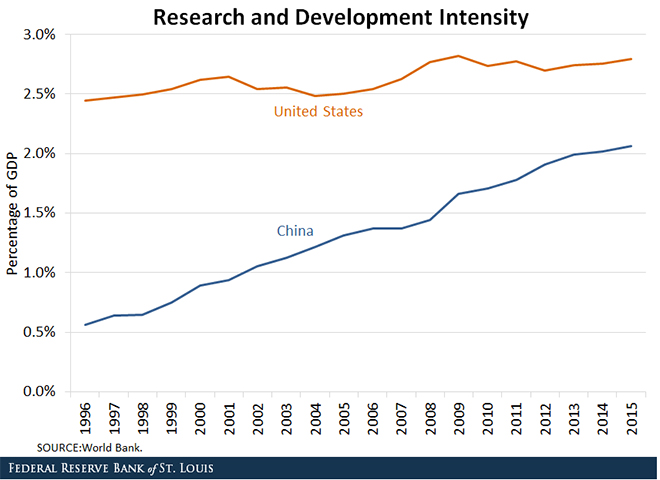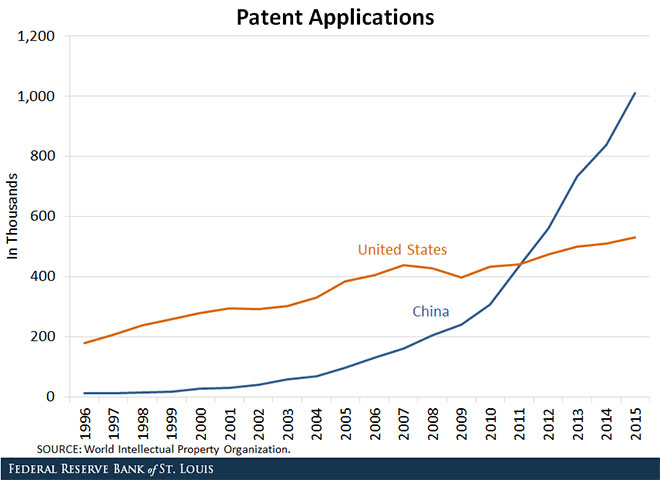The dominating role that the U.S. has had with respect to patent applications has been challenged in recent years. Is China becoming the new global leader in innovation?…
been challenged in recent years. Is China becoming the new global leader in innovation?…
The original article has been edited here for length (…) and clarity ([ ]) by munKNEE.com – A Site For Sore Eyes & Inquisitive Minds – to provide a fast & easy read.
Two measures of innovative activity of a country are:
- Its research and development (R&D) intensity (that is, the fraction of total output invested in R&D), which reflects the effort of innovation
- Its number of patent applications, which reflects the output of innovation
Larger R&D investment is associated with faster technological progress, higher productivity and faster output growth.
One of the outcomes of the R&D process is an increase in the number of patent applications. A patent gives the owner a monopoly right to use this new invention for a limited period, generally 20 years. Indeed, there tends to be a positive correlation between the R&D intensity of a country and the number of patent applications in that country.
R&D Intensity: China vs. the U.S.
- In 1996, China invested 0.56% of its GDP in R&D, while the U.S. invested 2.44% of its GDP.
- In 2015, China invested 2.06% of its GDP, whereas the U.S. invested 2.79%. That is, the R&D intensity in China increased by 1.5 percentage points and in the U.S. by only 0.3 percentage points.

Patent Applications: China vs. the U.S.
Regarding patent applications,
- the U.S. applied for 177,967 patents in 1996, which contrasts with the 11,974 patent applications in China that year.
- However, in 2015, China exceeded the U.S. in the total number of patent applications by 90%, as seen below.

The dominating role that the U.S. has had with respect to patent applications has been challenged in recent years. Is China becoming the new global leader in innovation?…
Why Has China’s Innovation Increased?
There may be several reasons why China is innovating so much more than before.
- For instance, technological developments in China together with a growing market may favor investment in innovation.
- Moreover, the government has been very active at implementing policies to incentivize innovation in China.
- In 2006, the Chinese government announced the National Indigenous Innovation Campaign, which includes a goal to transform China into the world’s technology powerhouse by 2020…
- In addition, the 12th and 13th “five-year” plans (2011-2020) detailed goals for R&D intensity and patent applications. The government offered subsidies targeted to increase the number of patent applications. This could explain why patent applications have grown way faster than R&D intensity.
A Deeper Look at China’s Innovation Path Needed
In conclusion,
- in terms of R&D intensity, China is approaching the U.S. but still remains behind.
- in terms of patent applications, however, China has overtaken the U.S. and appears to be the new global leader of innovation.
[The being said, however,]…one should control for the quality of the patents to determine whether China is indeed the new global leader in innovation based on the number of patents…If China wants to become the world’s technology powerhouse, more R&D investments targeted to a wider range of industries are needed.
Related Articles From the munKNEE Vault:
1. Economic Differences Between the U.S. & China – Take A Look
Today’s infographic looks at the economic differences between the U.S. and China: total reserves, foreign direct investment, demographics, imports, exports, GDP per capita, energy, education, and much more. Take a look.
2. Now You, Too, Can Predict When China Will Overtake America Using This Cool Interactive Tool
America’s GDP is still roughly twice as big as China’s (using market exchange rates). To predict when the gap might be closed, The Economist has updated its interactive chart below with the latest GDP numbers. This allows you to plug in your own assumptions about real GDP growth in China and America, inflation rates and the yuan’s exchange rate against the dollar. [Plugging in our assumptive] numbers China will overtake America in 2018. [Share your prediction in the “Comments” section at the bottom of the page.]
3. A Comparison Of the Military Forces of China & the U.S.
To be considered a true force, China needs to be able to back up its economic and political might with a top notch military. Today’s infographic compares the armed forces of China with the United States.
4. China Can’t Compete Economically With the U.S. – Here’s Why
Since the launch of economic reforms in 1978, China has become the world’s second-largest economy, the largest merchandise trader, the largest manufacturer and the largest creditor of the U.S…BUT the nation is still a laggard in so many respects that it still can’t compete with the United States. Let’s take a look at why that is the case.
5. The 21st Century Will Belong to the U.S. & NOT China – Here’s Why
“The American Century Ends, and the Pacific Century begins.” Seriously? We say B.S. to that. This moment in history is not the end of American dominance. If anything it is a beginning. In terms of dominance, America has barely rolled up its sleeves. Let me explain.
For all the latest – and best – financial articles sign up (in the top right corner) for your free bi-weekly Market Intelligence Report newsletter (see sample here) or visit our Facebook page.
 munKNEE.com Your Key to Making Money
munKNEE.com Your Key to Making Money